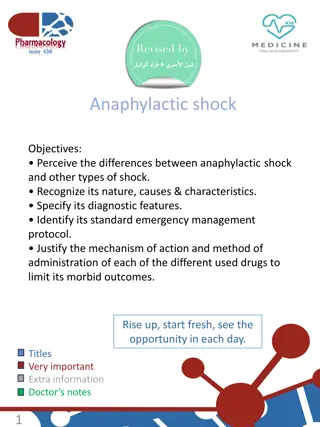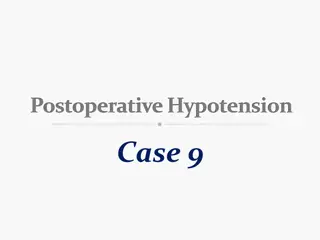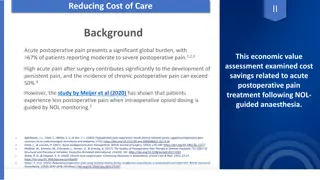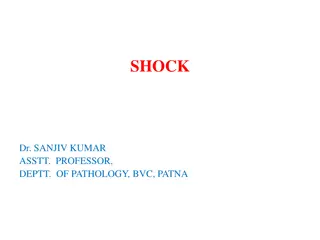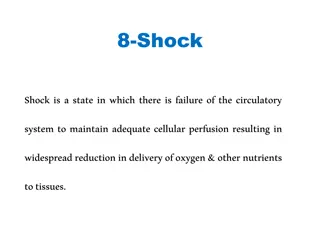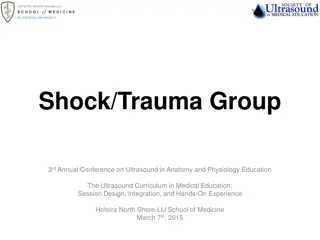Understanding Postoperative Shock and Respiratory Failure
Postoperative shock refers to different types of shock that may occur after surgery, such as hypovolemic, cardiogenic, or septic shock. It is crucial to recognize the signs and symptoms of shock early to prevent irreversible consequences. On the other hand, respiratory failure can be acute or chronic, and it requires careful diagnosis and coding to ensure proper treatment. Understanding these conditions is essential for healthcare professionals dealing with postoperative patients.
Download Presentation

Please find below an Image/Link to download the presentation.
The content on the website is provided AS IS for your information and personal use only. It may not be sold, licensed, or shared on other websites without obtaining consent from the author. Download presentation by click this link. If you encounter any issues during the download, it is possible that the publisher has removed the file from their server.
E N D
Presentation Transcript
Mary Byrne RN CCDS NYP/Lawrence 4/4/2018
ICD-9-CM Coding Clinic, Fourth Quarter 2011 Pages: 150-153 Effective with discharges: October 1, 2011 Postoperative shock Related Information Effective October 1, 2011, codes 998.00, Postoperative shock, unspecified; 998.01, Postoperative shock, cardiogenic; 998.02, Postoperative shock, septic; and 998.09, Postoperative shock, other, were created to describe specific types or mechanisms of postoperative shock. Shock is a physiologic state characterized by a decrease in the volume of blood that flows through the tissues causing a reduction in the amount of oxygen throughout the body. This reduction in oxygen may be a result of impaired binding of oxygen molecules to hemoglobin or the decrease in circulation of oxygenated blood. The effects of the imbalance between oxygen delivery and demand are initially reversible but rapidly become irreversible: cell death, end-organ injury, multi-system organ failure and death. Manifestations of shock include low blood pressure (hypotension), tachycardia (in response to hypotension), pallor, cool and clammy skin, altered mental status, and decreased urine output. Hypovolemic shock is the most common type of shock seen in the postoperative patient. It occurs when large amounts of fluids are lost from hemorrhage or severe dehydration. Cardiogenic shock is attributable to a weakened heart not being able to pump enough blood to organs of the body. Causes include myocardial infarction, pericardial tamponade and heart failure. Vasodilatory shock is when the blood vessels expand too much with decreased distribution of blood. The most common types are septic shock, severe infection with end-stage systemic inflammatory response syndrome and anaphylactic shock due to severe allergic reaction. Postoperative patients can experience any of these different types of shock. Internal bleeding from poor surgical technique or disseminated intravascular coagulation may lead to hemorrhagic shock, which is treated with blood products. Postoperative volume shifts, also known as third spacing, may lead to nonhemorrhagic hypovolemic shock, which is treated with intravenous fluids. Postoperative Question: Answer: Okay to break up into two pages if long
Hypoxemia with acute respiratory failure, Coding Clinic, 2nd quarter 2006, p 25 Respiratory failure is a life-threatening condition that is always due to an underlying condition. It may be the final pathway of a disease process or a combination of different processes. Respiratory failure can result from either acute or chronic diseases that cause airway obstruction, parenchymal infiltration, or pulmonary edema. It can arise from an abnormality in any of the components of the respiratory system, central nervous system, peripheral nervous system, respiratory muscles, and chest wall muscles. The diagnosis is based largely on arterial blood gas analysis findings, which vary from individual to individual, depending on several factors. Never assume a diagnosis of respiratory failure without a documented diagnosis by the physician. Respiratory failure is classified as acute (J96.0-), chronic (J96.1-), acute and chronic combined (J96.2-), or unspecified (J96.9-), and a fifth character is used to specify whether hypoxia or hypercapnia is present. When respiratory failure follows surgery, code J95.821, Acute postprocedural respiratory failure, or code J95.822, Acute and chronic postprocedural respiratory failure, is assigned. Careful review of the medical record is required for the coding and sequencing of respiratory failure. Review the circumstances of admission to determine the principal diagnosis. Code J96.00, Acute respiratory failure, unspecified whether with hypoxia or hypercapnia, or code J96.20, Acute and chronic respiratory failure, unspecified whether with hypoxia or hypercapnia, may be assigned as a principal diagnosis when the respiratory failure is the condition established after study to be chiefly responsible for occasioning the admission to the hospital, and the selection is supported by the Alphabetic Index and Tabular List. Respiratory failure may be listed as a secondary diagnosis if it develops after admission. January 18, 2018 3
Case Study Patient seen and examined in the ED. Essentially ,this is a 67 y/o/m, s/p right kidney cyst removal on 2/9/18, at other hospital, BIBA with c/o hematuria associated with right flank pain and mild dizziness .Post-procedure ,the patient was started on eliquis ,has been taking eliquis and ASA. In the ED, the serum Hgb was noted to be 8.0.CT of the abdomen and pelvis was obtained and was reported as: Upper abdominal predominant pneumoperitoneum concerning for perforated viscus. Moderate volume high density abdominopelvic free fluid most compatible with hemoperitoneum .The patient was evaluated by surgery ;as per surgery, the CT findings are most likely related to recent renal procedure. ICU evaluation was requested .When I saw the patient ,he was laying on a bed in the hallway ,he looked comfortable ,in no apparent distress, he stated that he felt better. His V/S were:143/70-20-94-98.2- SPaO2: 96%.At first,, the patient was not accepted to the ICU. However, while in the ED awaiting to be admitted to the GMF, the patient became hypotensive again; BP decreased from 143/70- 81/44 repeat . Lactic acid 2.2 serum Hgb was: 5.5;therefore the patient was upgraded to the ICU. Treated with iv fluids, Despopressin and was transfused. In ICU pt. developed pulmonary edema, o2 sats dropped to 89% with increased resp rate to 26 and pulse 121- placed on bipap. Creatinine increased from 1.67- 3.3 and remained elevated
QUERY OPPORTUNITY **Upon transfer to floor Diagnosis Codes- Post Procedural Hemm following a procedure/ Hemoperitoneum/ AKI/ Acute Blood Loss Anemia/Pulmonary Edema SOI/ROM PRESENTLY AT 4/3 Query for Hemorrhagic shock Acute Resp Failure with hypoxemia ATN Impact: SOI/ROM INCREASED to 4/4
Thank You kseekircher@nwhc.net January 18, 2018 8




